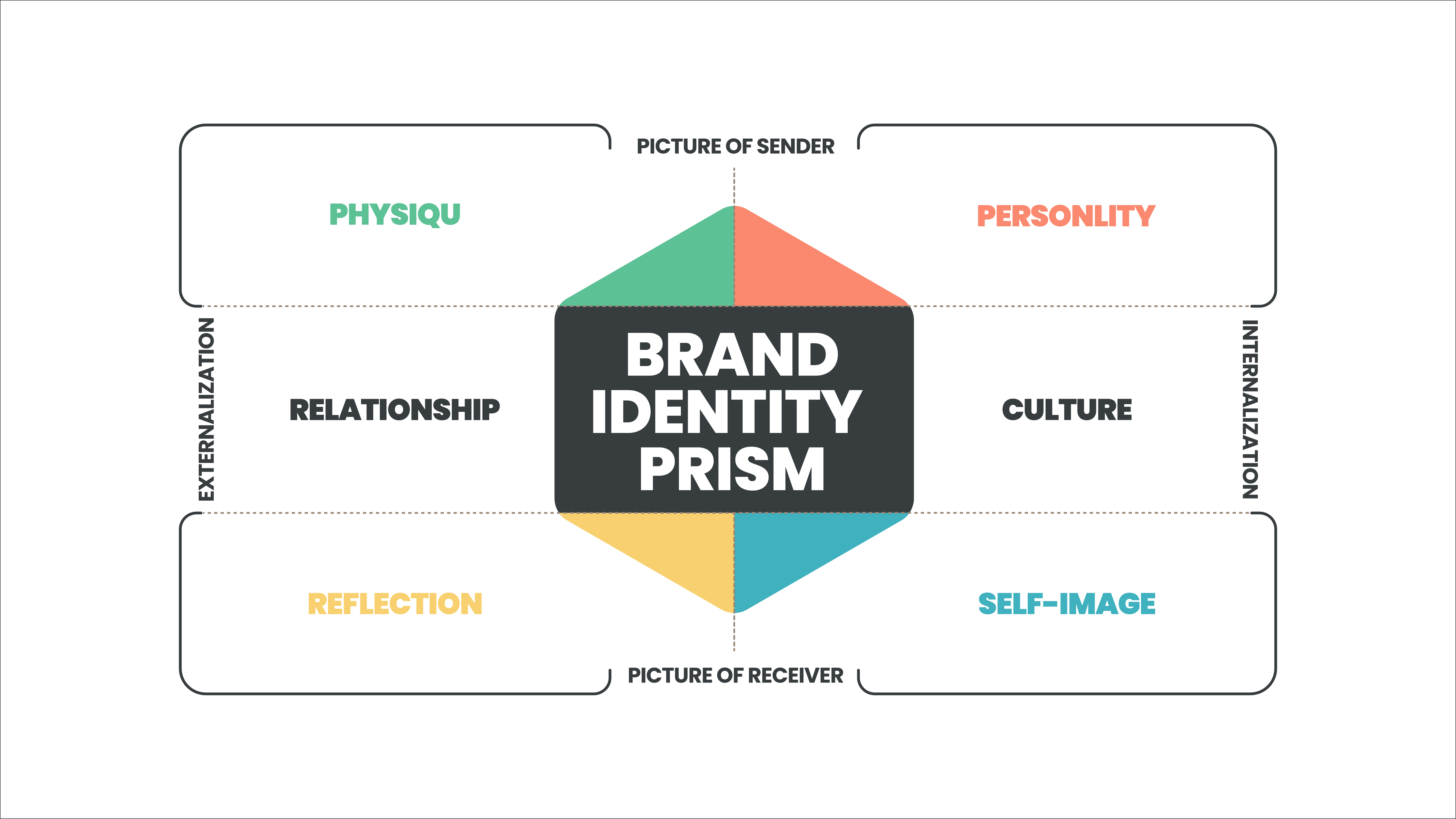Unraveling the Tapestry of Brand Identity: An In-Depth Exploration of the Brand Identity Prism
Intro:
In the ever-evolving world of branding, the term “brand identity prism” echoes with profound significance. This post embarks on a comprehensive journey to untangle the complexities of this pivotal concept, shedding light on the reasons why Jean-Noel Kapferer’s prism has become an indispensable tool for understanding and managing brand elements.

The Foundation: Deciphering the Brand Identity Prism
In 1986, Jean-Noel Kapferer introduced a revolutionary concept to the realm of branding. This concept aimed to transform the nebulous and abstract notion of a brand into a tangible, comprehensible entity. Kapferer’s model meticulously dissects brand identity into six measurable elements:
- Physique
- Personality
- Culture
- Self-Image
- Reflection
- Relationship
While these elements may initially appear intertwined, a closer examination reveals their distinct roles in shaping the perception and experience of a brand. In the following sections, we’ll delve into each element, employing real-world examples to elucidate their application.
Deciphering the Essence of Brand Physics
Brand physics, the foundational element in Kapferer’s model, refers to the tangible and sensory aspects of a brand. It encompasses elements with a palpable form that stakeholders can perceive through various senses. These tangible components include logo design, color palette, product packaging, and sensory elements like scent and visual identity. The tangible nature of brand physics imparts a profound and immediate influence on consumers, shaping their initial perception of a brand.
An exemplary manifestation of brand physics is found in the globally recognized Coca-Cola brand. The iconic logo, coupled with the timeless red, white, and black color scheme, transcends cultural boundaries, making it a universally acknowledged symbol. The meticulous design of these tangible elements has contributed to Coca-Cola’s status as a powerful and memorable brand.
Understanding the Living Essence of Brand Personality
Brand personality, within Kapferer’s model, envisions the brand as a living entity endowed with human-like characteristics. This element focuses on the tone of communication, style, and alignment with various archetypes to shape the brand’s persona. When successfully executed, brand personality creates a connection with consumers, evoking emotions and building a lasting brand image.
Consider Nike, a brand synonymous with athleticism, health, triumph, and championship. Every encounter with the Nike brand strategically crafts a connection with a motivated and athletic persona, resonating profoundly with its target audience. Nike’s brand personality goes beyond products; it becomes a lifestyle and an inspiration for those who associate with its values.
Delving into the Ethos of Brand Culture
Brand culture delves into the values and commitments that a brand upholds, shaping its ethos and defining its do’s and don’ts. This element determines the moral compass of a brand, influencing its decisions, innovations, and relationships. Commitments to honesty, transparency, innovation, environmental consciousness, and customer well-being exemplify brand culture, creating a framework that guides the brand’s actions.
Apple’s unwavering commitment to innovation serves as a compelling example of brand culture. This commitment has positioned Apple as a trailblazer in the technology landscape, introducing groundbreaking products and reshaping the way people engage with technology. The brand culture permeates every aspect of Apple’s identity, influencing not just products but also the entire user experience.
Navigating Communication Dynamics in Brand Communication
Brand communication is the element that defines how a brand interacts with its customers. It goes beyond the product or service, encompassing the overall customer experience and relationship. Factors such as friendliness, long-term customer support, and recognition of personal lives contribute to brand communication. Successful brand communication fosters loyalty and connection with the audience.
Starbucks, the world’s largest coffee shop chain, strategically positions itself as a ‘third place’—a space beyond home and workplace. The brand communication goes beyond the transactional nature of a coffee purchase; it creates an experience where customers feel a sense of camaraderie and friendship. The friendly interactions at Starbucks reinforce a feeling of intimacy, making it more than just a coffee destination.
Crafting the Mirror: Self-Image in the Brand
Self-image in the brand reflects what customers perceive when encountering the brand—a mirror projecting the potential appearance of customers when using the brand’s products. This element involves shaping the narrative of how customers see themselves in association with the brand. Successful self-image branding allows a business to establish its position in the customer’s life story.
Consider Levi’s, a brand projecting an image of attractiveness and comfort within American culture. Customers of this brand see themselves as attractive and ‘cool’ in social settings when adorned in Levi’s products. The self-image projected by Levi’s is carefully crafted to appeal to individuals seeking a specific persona for social situations, effectively becoming a part of their identity.
Beyond the Mirror: Unraveling Brand Reflection
Brand reflection, though seemingly akin to self-image, diverges significantly. In brand identity, reflection assesses the business’s connection with customers and how it presents them across various channels. This element involves the strategic portrayal of the brand’s association with its target audience.
Consider Patagonia, a brand committed to environmental sustainability and outdoor adventure. Patagonia strategically reflects an image of environmentally conscious and adventurous individuals, enhancing the brand’s identity and appealing to those seeking sustainable and adventure-driven lifestyles. The brand association goes beyond products; it aligns with a community of like-minded individuals who share a common ethos and lifestyle.
Delving Deeper into Significance: Jean-Noel Kapferer’s Branding Model
Jean-Noel Kapferer’s branding model is pivotal, transforming the abstract branding process into tangible elements and answerable questions. The model emphasizes the intricate connection between these elements and the brand’s overall identity. However, successfully implementing this model requires expertise and a nuanced understanding of each element’s role and significance.
At Shahrtash Studio, our services are meticulously designed to provide comprehensive answers to the intricate questions posed by each element of the brand identity prism. Our brand books act as guiding beacons for businesses seeking to infuse all six elements of brand identity with precision and detail, enabling them to distinguish themselves in a competitive landscape.
Elevating Your Brand’s Identity
If you aspire to cultivate a brand that encompasses all facets of brand identity with meticulous attention to detail, differentiating yourself from competitors, reach out to us at Shahrtash Studio. Our goal is to help you elevate your brand to new heights by crafting a distinctive and resonant identity that captivates your audience. Through our comprehensive approach, we ensure that your brand stands out, communicates effectively, and establishes a lasting connection with your target audience.

In Conclusion: Navigating the Tapestry of Brand Identity
The brand identity prism serves as a compass for businesses navigating the complex world of branding. Understanding and leveraging these six elements empower brands to create a compelling identity that resonates with their audience, fosters connection, and stands the test of time. Each element, carefully woven into the tapestry of brand identity, contributes to the creation of a brand that is not just seen but deeply felt and remembered. As businesses navigate this intricate landscape, the brand identity prism becomes an indispensable tool for shaping a brand that transcends the ordinary, leaving a lasting imprint on the minds of consumers.
Are you ready to start your branding project? Be in contact with us.


